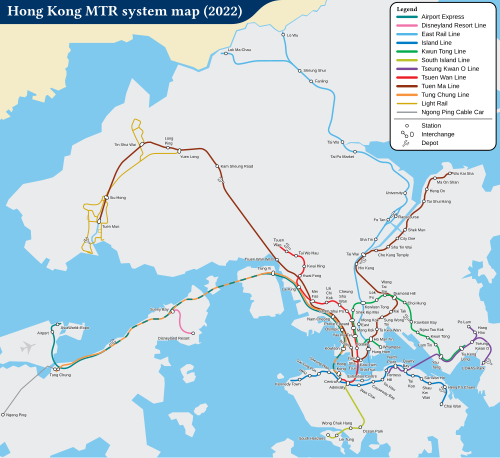Before I go into the rest of the MTR lines, I’ll go through a short overview of the network:
You can see a complete track diagram of the system (including sidings and depots) at this page – the rest of the site is rather interesting, at least after you pass it through Google Translate!
You can initially divide the MTR network into two parts: the original MTR underground network, and the former KCR above ground network. There are no track connections between the two networks, and they use incompatible electrification schemes: while both use overhead lines the MTR uses 1500 V DC while the KCR is 25 kV AC. You can also divide it up further, into the following groups:
Urban Railway Lines (URL): the initial part of the MTR network, consisting of the Island Line, Kwun Tong Line and Tsuen Wan Line, with the Tseung Kwan O Line added later. The majority of this section is in underground tunnels, the exception being a few short sections of above ground viaduct in the outer suburbs.
These lines all use the refurbished “M-Train” EMU built by Metro Cammell and refurbished by United Goninan, with the newer Tseung Kwan O Line using the “K-Stock” EMU instead. These four lines operate independently with their own depots to maintain their separate train fleets, but there are a number of track linkages between them should the need arise for transfers.
These lines also use compatible ATP / ATO systems (Automatic Train Protection / Automatic Train Operation). The first three lines were initially provided with an analogue track-based ATP system with a digital ATO system, being replaced by a GEC Alstom provided SACEM system in the late 1990s to increase the train capacity. With the opening of the Tseung Kwan O Line the same SACEM system was installed, but this time provided by Siemens.
The fully automated system leaves only leaving door operation and starting the train in the hands of the train operator. There are plenty more technical details in the IRSE paper (“Interoperability of ATC Systems, Hong Kong MTR Experiences” by L.Y. Lam, principal consultant MTR Corporation) and this Siemens brochure.
Lantau Airport Railway (LAR): this network consists of two lines, the Tung Chung Line and the Airport Express, with majority of the route ballasted track at ground level. These lines share a large amount of track in their journey from central Hong Kong out to the airport and the adjacent New Town of Tung Chung, but have separate platforms. Both lines use the “A-Stock” EMU but with different interior fitouts to suit the traffic they serve.
The ATP / ATO system is again SACEM provided by Alstom. The Disneyland Resort Line also connects to the Lantau Airport Railway at Sunny Bay, enabling the trains to access the shared depot at Siu Ho Wan. Trains on this branch do not need drivers, a SelTrac LS ATO system provided by Alcatel enables Fully Automatic Operation (FAO). More detail on this system is in this IRSE newsletter. I didn’t think there was a track connection between the LAR and URL lines, but there turns out to be a single connection at Lai King.
East Rail: the original part of the KCR network, located at ground level it shares the tracks with freight and intercity trains. Refurbished Metro Cammell EMUs are used, along with a handful of SP1900 EMUs. An ATP system was introduced in 1998, and in 2002 an Alstom ADVANTIK ATO system was added.
West Rail and Ma On Shan: both recent extensions to the KCR network, they have track connections to the East Rail Line, but have their own depots for the maintenance of trains and track. The majority of track is on viaducts, except for West Rail through Kowloon. Both lines use SP1900 EMUs and a SelTrac IS ATO system, which are not compatible with the systems on East Rail.
The Tsing Yi Operations Control Centre manages train operations on the original MTR part of the network, while a centre at Fo Tan manages the ex-KCR East Rail and Ma On Shan lines, and a third centre at Kam Tin manages the West Rail line. The Tsing Yi centre replaced the original centre at Kowloon Bay in 2000, as described in the second part of this IRSE paper.
For further reading, there are at least two websites in English:
- Hong Kong Railway Information Centre (a dead Geocities site, but accessible via the Internet Archive)
- Hong Kong Mass Transit InfoCenter (out of date since 2004)
If you use Google Translate the previously mentioned website at http://mtr.hk365day.com/ is full of interesting bits, and there is a Chinese only railway discussion board at http://www.hkrdb.net/ that is worth a browse.



Pingback: Railway signalling on the MTR underground | Checkerboard Hill
Pingback: Getting your own set of wheels | Checkerboard Hill
Pingback: Three years of changes to Hong Kong transport - Checkerboard Hill
Pingback: Operating divisions of the MTR rail network - Checkerboard Hill